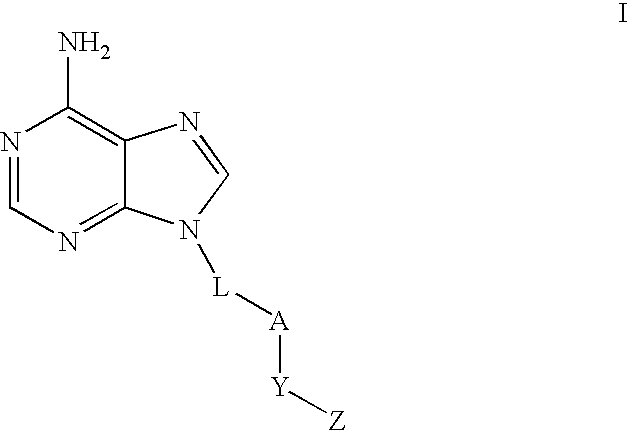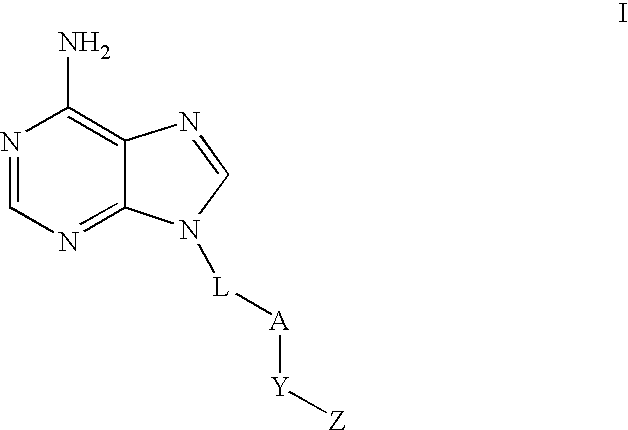Regulation of type 5 adenylyl cyclase for treatment of neurodegenerative and cardiac diseases
a technology of adenylyl cyclase and neurodegenerative diseases, applied in the field of type 5 adenylyl cyclase, can solve the problems of inability to address this issue in vitro experimental approaches, development of tolerance after chronic use of this medication, and impaired organ function
- Summary
- Abstract
- Description
- Claims
- Application Information
AI Technical Summary
Benefits of technology
Problems solved by technology
Method used
Image
Examples
example 1
General Procedure A—Adenine Alkylations
[0188] Adenine (1.18 mmole) was combined with an alkyl bromide (3.54 mmoles), K2CO3 (5.91 mmoles) and DMF (5.00 mL). The mixture was heated to 60° C. for 20 hours. After cooling to room temperature, the reaction was diluted with brine (50 mL) and washed with EtOAc (3×20 mL). The combined organic washes were dried over anhydrous MgSO4, filtered and concentrated to dryness. The product was purified on silica gel (5% MeOH / CHCl3).
General Procedure B—Hydroxamic Acids
[0189] KOH (3.8 M in MeOH, 0.45 mL) was added to HONH2.HCl (1.6 M in MeOH, 0.67 mL) and cooled to 0° C. for 2 hours. A methyl or ethyl ester (0.15 mmoles) was dissolved in MeOH (0.31 mL) and the HONH2 solution was added by filtration. After stirring for 45 minutes at room temperature, the reaction was concentrated to dryness and the residue was purified by reverse phase preparative HPLC (0-10% CH3CN / 30 minutes). The isolated product was desalted with MP-carbonate resin (Argonaut) in...
example 2
Generation of Knockout Mice
[0313] The targeting construct was prepared by ligating a 2.2-kb XhoI-PstI fragment from the 5′ end of the type 5 AC gene, containing the exon with the first translation initiation site (5′-arm), a 1.7-kb fragment containing a neomycin resistance gene fragment (neo) driven by a phosphoglycerate kinase (PGK) promoter, and a BssHII-NcoI 7.0-kb fragment of the type 5 AC gene (3′-arm), into pBluscript II KS (Stratagene, La Jolla, Calif., USA). The type 5 AC gene has another translational start site accompanied by a reasonable Kozak consensus sequence located 738-bp downstream of the first translational start site within the same exon. To impair the second site, inventors excised a 0.15 kb PstI-BssHII fragment containing the second ATG and replaced it with a PGK-neo cassette in the final targeting vector (FIG. 1A).
[0314] Embryonic stem cells were transfected with 50 μg linearized targeting vector by electroporation (Bio-Rad Gene pulsar set at 250 V and 960° ...
example 3
AC Assay
[0331] Hearts were dissected from the mice, and membrane preparations were prepared as described previously. Protein concentration was measured by the Bradford method using bovine serum albumin as a standard. AC activity was measured as described previously. AC activity was linear within the incubation time up to 30 min. For the study of Ca 2+ inhibition, the membranes were treated first with EGTA to extract the endogenous Ca 2+ prior to the assay. Free Ca 2+ concentrations were obtained with the use of 200 μmol / L EGTA buffers as described previously. The experiments with Ca 2+ inhibition were conducted in the presence of 100 μmol / L isoproterenol (ISO)+100 μmol / L GTP.
Physiological Studies
[0332] Electrocardiogram (ECG) wires, a jugular vein catheter for drug infusion, and a femoral artery catheter for arterial pressure monitoring were implanted under anesthesia as described previously. Measurements of left ventricular ejection fraction (LVEF) were taken using echocardiog...
PUM
| Property | Measurement | Unit |
|---|---|---|
| Density | aaaaa | aaaaa |
| Electrical resistance | aaaaa | aaaaa |
| Heart rate | aaaaa | aaaaa |
Abstract
Description
Claims
Application Information
 Login to View More
Login to View More - R&D
- Intellectual Property
- Life Sciences
- Materials
- Tech Scout
- Unparalleled Data Quality
- Higher Quality Content
- 60% Fewer Hallucinations
Browse by: Latest US Patents, China's latest patents, Technical Efficacy Thesaurus, Application Domain, Technology Topic, Popular Technical Reports.
© 2025 PatSnap. All rights reserved.Legal|Privacy policy|Modern Slavery Act Transparency Statement|Sitemap|About US| Contact US: help@patsnap.com



